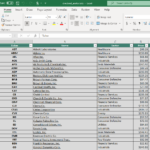This article/post contains references to products or services from one or more of our advertisers or partners. We may receive compensation when you click on links to those products or services
Retirement can be a complex time to plan for. It’s decades away and there are so many investment options to choose from. Things can get overwhelming quickly.
This is why some helpful — and easy-to-understand — formulas for retirement savings have been created. Using these simple strategies, such as the 25x Retirement Rule, the average Joe can realistically understand how much money they need for retirement and how to get there.
In this guide, we’ll explain what the 25x Rule is and how to use it for your retirement planning.
The Short Version
- The 25x Retirement Rule allows you to estimate how much you’ll need to have saved to get through 30 years of retirement.
- For those who plan to retire early, the 25x Rule may not be a high enough estimate, since it only shows your savings for 30 years worth of expenses.
- The 25x Rule doesn’t account for inflation or sources of income like Social Security and rental properties.
What Is the 25x Retirement Rule?
Back in 1998, three professors from Trinity University released what’s commonly known today as the Trinity Study. This study calculated what a “safe” withdrawal rate would be during retirement if you have a portfolio that has stocks and bonds. The professors assumed a 30-year retirement period and found that you should be able to withdraw 4% of your total investment portfolio each year.
So where does 25x come in? In order to stick with the 4% withdrawal rate, most people would need to have 25 times of their annual expenses in their portfolio. The math is simple:
How Does The 25x Retirement Rule Work?
The 25x Rule is simply an estimate of how much you’ll need to have saved for retirement. You take the amount you want to spend each year in retirement and multiply it by 25.
Generally, you can look at your current salary to get an idea of how much you might be able to comfortably live off in retirement. Here’s a simplified example: If you want to have $50,000 for each year in retirement, you’ll multiply that $50,000 by 25, leaving you with $1,250,000.
This also gives a more realistic target that you can save for over time. However, there are additional factors you need to consider once you do get to retirement, including:
- Your basic expenses might change — These are costs like your mortgage/rent, utilities, food, and more. As you go through retirement, your living situation may change. Consider the fact that you may need or want to move to a retirement community or downsize your home.
- Loan payments — Just because you enter your golden years doesn’t mean you won’t have loans to worry about. A home loan or a car loan are expenses you’ll need to be able to pay back, even when you can’t rely on a steady income stream from working each week.
- Healthcare costs — This is where you’ll likely have to plan to spend more than you did when you were younger. When you get older, you can potentially develop health issues. From doctors’ appointments to in-home care, this can rack up a hefty bill. Fidelity estimates that a retired couple currently needs $315,000 saved, on average, to cover health care costs.
- Your wants — You’ve worked hard to reach retirement. Many retirees want to spend their retirement traveling or trying new experiences that they didn’t get a chance to try during their working years. Having money to spend on these wants is just as important as paying your regular bills.
Where to Invest Your Savings?
Where you invest your money is often a matter of personal opinion and personal investing goals, but some places to start are:
Retirement Accounts
Retirement accounts are offered by employers for a reason. They’re designed to help you pay for your retirement, whether you’re using a 401(k) or IRA. Still, these accounts will only offer a portion of what you potentially need during retirement. The general rule is by your 60s, you should have 10x your salary saved in your 401(k).
The Stock Market
The stock market has a long history of offering an average return of 10%. While it’s definitely meant for long-term investors, those who start young and continue to invest even during down periods will likely see their portfolios rebound and offer a return.
Low-Fee Index Funds
Perhaps one of the best investments, according to the opinions of many different FI followers, is index funds. Index funds track a certain index (S&P 500, Dow Jones, etc.) and hold multiple different stocks in one fund. This allows you to automatically diversify your portfolio without doing much work. Plus, there are many low-fee index funds available so you won’t have to pay an arm and a leg in fees to access these funds.
Read more>>How to Invest in Index Funds: Do It Right
Rental Properties
Investing in real estate is a double-edged sword. Those who see the most generous profits often own rental units they rent to tenants or short-term guests. This form of investing is not for the faint of heart. You have to have a down payment upfront to buy the property, find renters, and maintain the building — it is, in fact, its own job. That said, it’s an option that can potentially provide you with an income source during retirement.
How to Figure Out How Much You Need
Different financial experts and advisors have their own opinions on the exact formulas to find out how much you should save for retirement. At the end of the day, though, this number will be different for every person and family.
You’ll need to spend some time crunching the numbers, either on your own or with a financial advisor. Start by thinking about what you want your retirement to look for. Then, calculate how much you need to spend on the basics and your wants.
Thankfully, there are plenty of calculators that can help you get some rough numbers based on your retirement goals and how you invest. Here are our recommended calculators and tools.
Will The 25x Retirement Rule Really be Enough?
Now that the 25x Rule has existed for quite some time, critics have started to address some of the flaws in this rule. There are certain financial realities that individuals will need to take into account.
Early Retirees Need to Save More
For those working towards early retirement, their retirement years will be a lot longer than the “traditional” retirement. This means the 25x Rule might fall a little short for this group. For those who want to retire in their 30s, potentially doubling the rule may work since they would have doubled their expected retirement period.
Inflation Isn’t Accounted For
The 25x Rule is a very simple guideline for retirement savings, not a crystal ball. It doesn’t include outside factors such as inflation.
Unfortunately, it’s not possible to predict what inflation will do to your money by the time you reach retirement age. That’s why best to plan for the worst — overestimate how much you’ll need, with the assumption that you’ll have to deal with some inflation. The worst that can happen is you have more saved for retirement than you expect to need.
Adjust your savings for inflation>>8 Best Inflation-Proof Investments for 2022
Social Security and Other Income Isn’t Considered
Many retirees still earn some sort of income even after they have officially retired. The 25x Rule really only applies to the investments and savings you have, not the other income you expect to earn like Social Security, rental properties, and part-time jobs.
Once you start to factor in other potential streams of income, you may find that you can reduce your savings target. However, only do this if you’re absolutely sure that you can count on this extra income. Remember that it’s almost always better to over save than to under save.
A Certain Return on Your Investments Is Expected
This rule assumes that you invest and that those investments will offer a return. Since there’s no way to determine exactly what your return will be, you need to look at the 25x Rule as just an estimate. If your portfolio underperforms, you could be left without thousands of dollars you expected to have. This is why a diversified portfolio is so important.
Final Thoughts
When running the rough numbers for how much you’ll need to live on during retirement, the 25x Rule can give you a base number to start with. Using this number as the exact savings amount, on the other hand, is not the way to go.
Understanding what you need to have saved depends entirely on your goals during retirement and the investments you’re comfortable making.
It might be best to speak with a financial advisor at least once, so they can help you understand what you realistically need to save. They can run the numbers for you and help you design a plan that works for you.
Retire Your Way>>














